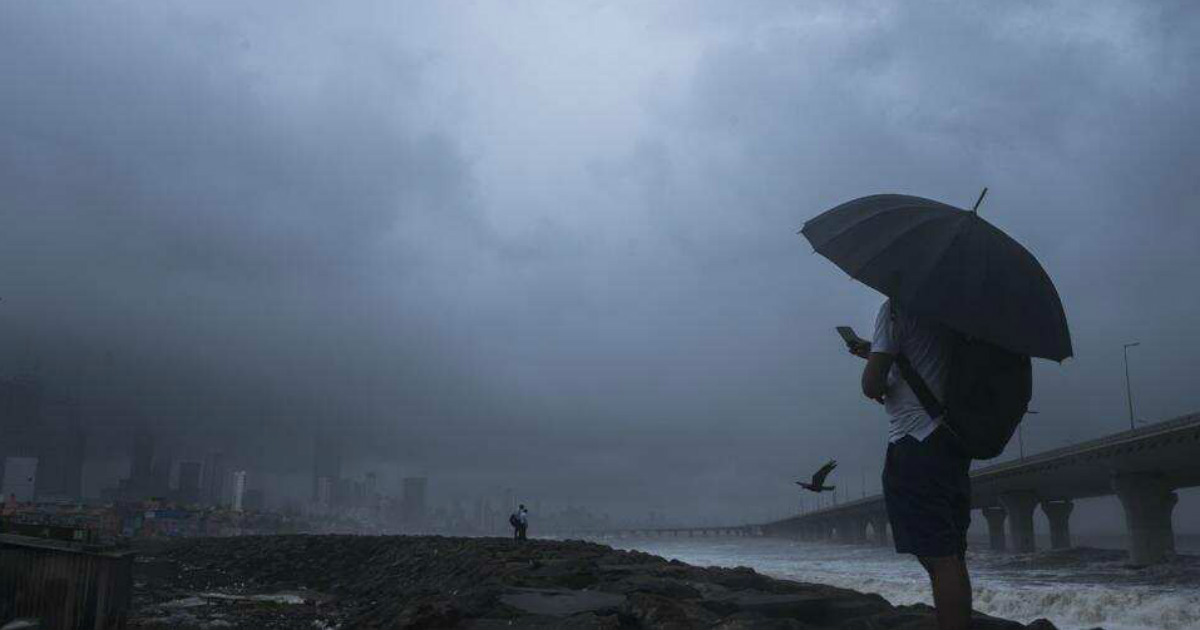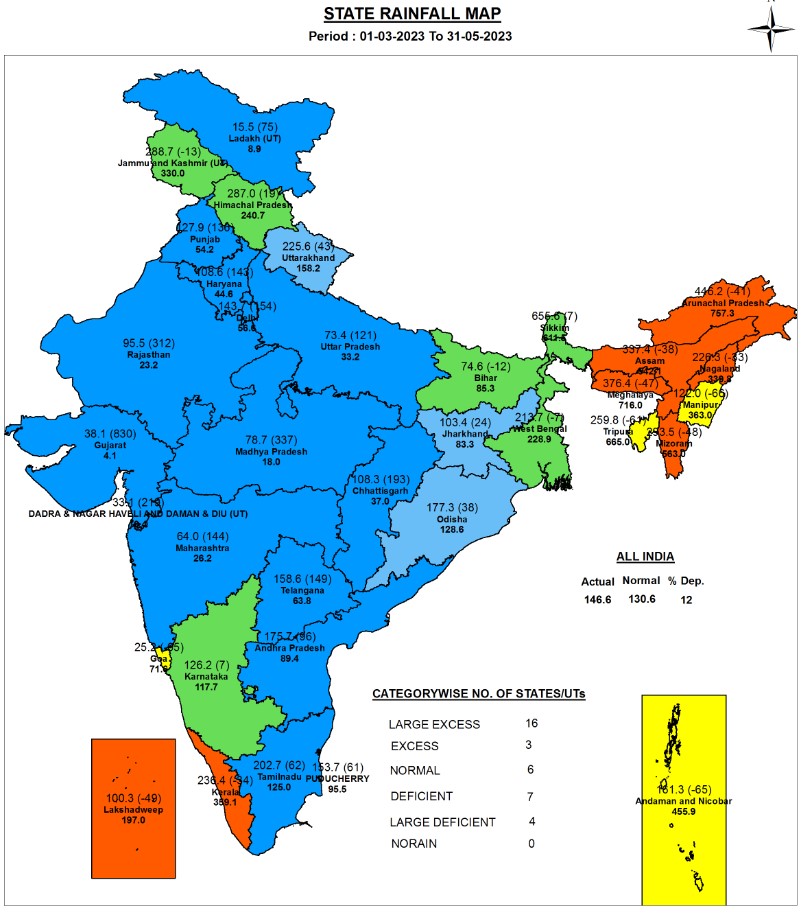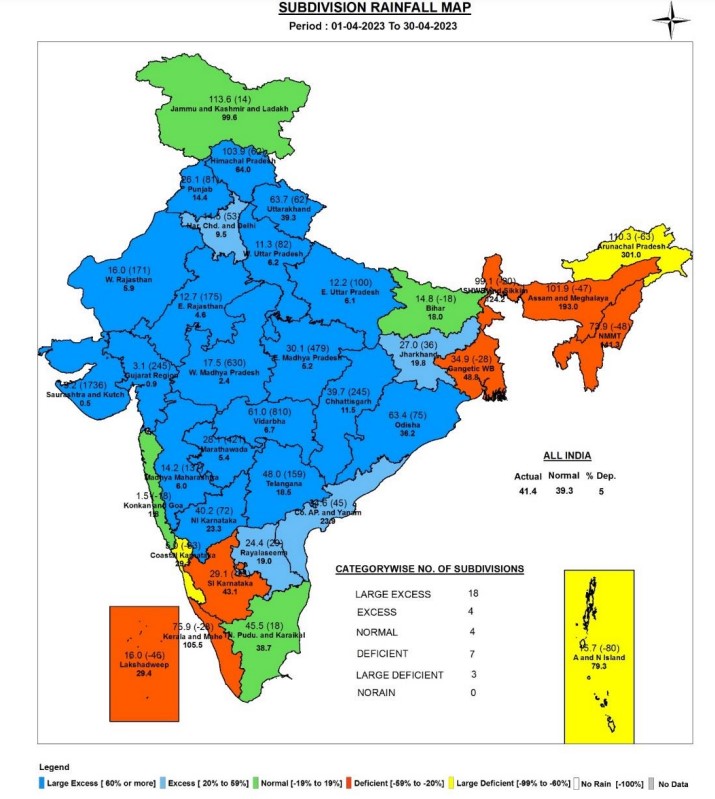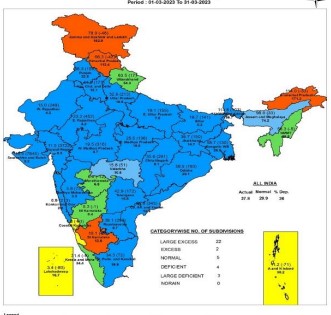Western Disturbances bring surplus pre-monsoon rains; heatwave remains absent
The pre-Monsoon season for the country ended with surplus rainfall to the tune of 12% of the Long Average Period (LPA). All three months (March-May) have recorded excess rainfall countrywide.
By Editorial Team / Jun 10, 2023

Image Credit: Skymet Weather
India records excess Pre-Monsoon Season 2023, gives heatwave a miss The pre-Monsoon season for the country ended with surplus rainfall to the tune of 12% of the Long Average Period (LPA). All three months (March-May) have recorded excess rainfall countrywide.


Data Source: IMD (Rainfall figures in mm)
While the majority rainfall contribution came from Central India, East and Northeast India was the only pocket to record deficit rainfall. Out of 36 sub-divisions of the country, 17 were large excess during the season, four saw excess rains, and 7 recorded normal rains. Meanwhile, six sub-divisions received deficient rains, while two were large deficient.
Excess rainfall led to below-normal maximum Temperatures observed over Northwest India, giving a miss to heatwave season this year. West Bengal was the only pocket to see a major heatwave spell from April 11-19. Following are the number of heatwave days observed across the country during the season.
Month-wise performance:
May: The month ended with surplus rainfall for the country to the tune of 10% of its LPA of 61.4 mm. Out of the 36 subdivisions of the country, 24 recorded normal to large excess rainfall, while others were deficient to large deficient.

According to the statistics, Northwest India recorded 67.3 mm of rain during May, the third highest since 1901. Before this, 1987 had recorded 95 mm, followed by 2021 with 68.2 mm during the month. Meanwhile, East & Northeast India received 111.3 mm of rainfall, the third lowest since 1901. Prior lowest rainfall years for the regions are 1907 with 108.1 mm of rain and 2012 with 109.6 mm.

Temperature Profile: With the above-normal rainfall, India recorded close to normal maximum and minimum average temperatures. The maximum temperature for the month was recorded at 35.03°C and the minimum temperature was 23.92°C, with an anomaly of -0.14°C and -0.40°C, respectively. The maximum temperature was above normal by 4.4°C mainly over most parts of North India and East & Northeast India and coastal parts of India.
Northwest India: Not only the rainfall, but the region also recorded the eighth-lowest average maximum temperature of 33.53°C, which was lower by 2.06°C since 1901. Similarly, the average minimum temperature was the seventh lowest at 20.09°C with an anomaly of -1.37°C during the same period. The mean temperature was also the eighth lowest at 26.81°C with an anomaly of -1.71°C since 1901.
Central India: The average minimum temperature for May was the sixth lowest at 25.20°C with an anomaly of -0.74°C since 1901.
East & Northeast India: In the absence of rains, the average maximum temperature was the eighth highest at 34.33 ºC with an anomaly of 1.30 ºC since 1901.
Heat Wave: Subdued heat wave conditions were observed during May, following similar trends in March and April 2023. Heatwave spells were observed for a span of 2-3 days over a few pockets of the country. The first week (1-8 May) and last week (24-31 May) did not observe heatwave across the country.
Weather Systems: May saw a series of back-to-back eight WDs, which is quite unusual during this time of the year. Passage of these systems led to widespread pre-Monsoon rains and thunderstorms, along with lighting, hail storm, and squally winds, especially over Northwest and Central India. These weather activities kept the maximum temperature below average over the regions.
April: The month also saw above-normal countrywide rainfall by 5% of its LPA. Central India recorded 30 mm of rain, which was the fourth highest since 1901. Meanwhile, East & Northeast India received 63.8 mm of rainfall which was the fifth lowest during the same period.

Out of the 36 subdivisions of the country, 26 recorded normal to large excess rainfall, while others were deficient to large deficient.

Weather systems: April witnessed five active Western disturbances (one in the first week of the month and four in the second half of the month). There was also the persistence of trough/wind discontinuity running from central to Peninsular India. Both weather systems together led to large-scale thunderstorm activities and rainfall, accompanied by lightning and gusty winds over India along with hail storms. Due to such extensive rain/thunderstorm activities and cloudy conditions over most parts of India, large parts of India experienced lower-than-normal day maximum temperatures during these periods.
The absence of weather systems along with south-westerly or southerly winds and moisture convergence from the north Bay of Bengal to the region was the reason behind the subdued rainfall and thunderstorm activities over northeast India in April.
Temperature Profile: The average maximum, average minimum and mean temperature for the country as a whole during April 2023 are 34.19°C, 22.08°C and 28.14°C respectively, against the normal of 33.94°C, 22.15°C and 28.04°C based on the period 1981-2010. Thus, the average maximum temperature is above normal by 0.26°C while the average minimum temperature and mean temperature are normal by -0.07°C and 0.10°C respectively for the country as a whole. The average Maximum temperature was above normal by 4.5°C mainly over most parts of East & Northeast India and coastal parts of South Peninsular India.
Peninsular India: Over South Peninsular India during April, the average maximum temperature is the seventh highest (35.03°C with an anomaly of 0.77°C).
Heat Wave: During April 2023, there was no heat wave during 1-10 April and 21-30 April due to the occurrence of thunderstorms and rainfall activities, especially over Northwest and West-Central India. During 12-20 April, heat wave condition was observed over West Bengal for 9 days, Bihar – 7 days, Odisha - 5 days, and Coastal Andhra Pradesh-4 days during the period.
Punjab, Haryana, Chandigarh, Delhi, and Uttar Pradesh saw heatwave conditions for 1-3 days, while Konkan & Goa and Jharkhand just saw one day of Heat Wave activity.
March: March was the best-performing month of the pre-Monsoon season 2023, with 26% surplus countrywide rainfall of its LPA. Out of the 36 subdivisions of the country, 29 recorded normal to large excess rainfall, while others were deficient to large deficient.

According to the statistics, Peninsular India recorded 32.1 mm during the month, the seventh highest since 1901. Similarly, Central India also saw the 11th highest rainfall during the same time period with 23.9 mm of rainfall.

Weather systems: After the hottest February in 123 years on account of the absence of Western Disturbances, March 2023 saw seven WDs formed moving across north and central India. Due to back-to-back WDs, an east-west trough was formed from Rajasthan to eastern India. Another north-south trough was seen running from south Peninsular India to east-central India, which is a semi-permanent feature during the pre-Monsoon season. The country saw widespread rainfall, especially from March 14-22.
Temperature Profile: The average maximum temperature for the country was recorded at 31.37°C, which was above normal by 0.13°C against the normal average of 31.24°C. Similarly, average minimum and mean temperatures were recorded above normal at 19.46 ºC and 25.41 ºC respectively, against the normal of 18.87°C and 25.06°C. However, these above-normal temperatures were the result of hot weather in the first half of the month. Maximum temperatures were below normal departure since March 17 because of thunderstorm activity over many parts of the country.
Heat Wave: No heatwave was recorded during the month.


